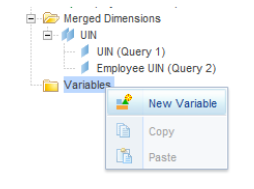In my HR model I want to introduce the concept of multiple hierarchies. It introduces and interesting design choice. Add the Hierarchy as a node or add it as a labeled relationship?
Using a Hierarchy node or labeled relationships are two approaches to managing multiple hierarchies in Neo4j. Each method has distinct advantages and disadvantages, depending on the complexity of your data model, the type of queries you need to run, and your scalability requirements.
Using a Hierarchy Node
Pros
-
Clear Separation of Hierarchies
- Each hierarchy has its own explicit
Hierarchynode, making it easy to visualize and reason about the different hierarchical structures. - Queries can target a specific hierarchy using a
BELONGS_TOrelationship to the rootHierarchynode, ensuring precision.
- Each hierarchy has its own explicit
-
Scalable for Complex Hierarchies
- You can manage as many hierarchies as needed simply by adding new
Hierarchynodes. This makes it easier to expand the ontology without major changes to the graph model. - Nodes can belong to multiple hierarchies by connecting them to different
Hierarchynodes, avoiding duplication.
- You can manage as many hierarchies as needed simply by adding new
-
Hierarchies Are First-Class Citizens
- Since hierarchies are nodes, you can attach metadata (e.g.,
created_by,last_updated,description) directly to theHierarchynode. This is especially useful for audit purposes or when hierarchies themselves need attributes.
- Since hierarchies are nodes, you can attach metadata (e.g.,
-
Flexibility in Querying
- Queries can traverse from the
Hierarchynode downward, enabling global insights for a specific hierarchy. For example, “Show all departments in the functional hierarchy.”
- Queries can traverse from the
-
Easy Debugging and Visualization
- Having a dedicated node for each hierarchy makes it easier to identify and visualize the structure of the graph.
Cons
-
Additional Relationship Hops
- Queries may require extra hops to traverse through the
Hierarchynode to the actual hierarchical relationships, which can slightly impact query performance, especially for deeply nested graphs.
- Queries may require extra hops to traverse through the
-
More Complex Modeling
- Adding a
Hierarchynode introduces another layer of abstraction, which may not always be necessary for simpler hierarchical structures.
- Adding a
-
Potential Redundancy
- If all nodes already belong to exactly one hierarchy, the
Hierarchynode may seem redundant, as the relationships themselves could define the hierarchy.
- If all nodes already belong to exactly one hierarchy, the
-
Overhead for Simple Queries
- For simple tasks like finding parent-child relationships, the
Hierarchynode adds extra complexity that may not provide tangible benefits.
- For simple tasks like finding parent-child relationships, the
Using Labeled Relationships
Pros
-
Simplicity
- Labeled relationships (e.g.,
BELONGS_TO_FUNCTIONAL,BELONGS_TO_GEOGRAPHICAL) are straightforward and avoid the need for additional nodes likeHierarchy. This keeps the graph model lean and simple.
- Labeled relationships (e.g.,
-
Performance Optimization
- Relationship traversals in Neo4j are highly optimized. By using labeled relationships, you can directly query a specific hierarchy without intermediate hops, which can improve query performance.
-
Easy Querying of Specific Hierarchies
- Queries can be more concise since they directly use relationship types to distinguish between hierarchies. For example:
MATCH (child)-[:BELONGS_TO_FUNCTIONAL]->(parent) RETURN child, parent;
- Queries can be more concise since they directly use relationship types to distinguish between hierarchies. For example:
-
Less Overhead for Simple Hierarchies
- When you only have a few hierarchies or simple use cases, using labeled relationships avoids the complexity of managing extra nodes.
-
No Need for Additional Properties
- Unlike the
Hierarchynode approach, you don’t need to add hierarchy metadata as separate nodes. Instead, the relationship name inherently defines the hierarchy type.
- Unlike the
Cons
-
Limited Scalability
- As the number of hierarchies grows, managing a large number of labeled relationships (e.g.,
BELONGS_TO_FUNCTIONAL,BELONGS_TO_GEOGRAPHICAL,BELONGS_TO_TEMPORARY) can become unwieldy. - Adding a new hierarchy requires creating a new relationship type and updating queries, which can introduce maintenance challenges.
- As the number of hierarchies grows, managing a large number of labeled relationships (e.g.,
-
No Metadata for Hierarchies
- Relationships in Neo4j cannot store as much metadata as nodes, so it’s harder to manage attributes for the hierarchy itself (e.g., description, creation date, owner, etc.).
-
Duplication in Queries
- Queries for multiple hierarchies require duplication of traversal logic. For example, to find nodes in multiple hierarchies, you might need separate queries for each relationship type or a cumbersome
ORclause:MATCH (child)-[:BELONGS_TO_FUNCTIONAL|BELONGS_TO_GEOGRAPHICAL]->(parent) RETURN child, parent;
- Queries for multiple hierarchies require duplication of traversal logic. For example, to find nodes in multiple hierarchies, you might need separate queries for each relationship type or a cumbersome
-
Harder to Visualize
- Labeled relationships can make the graph harder to visualize, especially when nodes are connected to multiple hierarchies using different relationships. It can clutter the graph representation.
-
No Unified Root
- Without a
Hierarchynode, there’s no single point to unify and traverse all nodes within a hierarchy. For example, you can’t easily find “all hierarchies in the graph” or attach global metadata.
- Without a
When to Use Each Approach
| Criteria | Hierarchy Node | Labeled Relationships |
|---|---|---|
| Number of Hierarchies | Many hierarchies (>3) | Few hierarchies (1-3) |
| Need for Metadata on Hierarchies | Yes | No |
| Query Performance | Secondary consideration | High priority |
| Graph Complexity | Complex hierarchies or overlapping | Simple, distinct hierarchies |
| Flexibility for Growth | High scalability | Less scalable |
| Ease of Querying | Requires more hops but is flexible | Direct and fast |
Hybrid Approach
In some cases, a hybrid approach works best. For example:
- Use
Hierarchynodes for global hierarchy management and metadata. - Use labeled relationships within a specific hierarchy to streamline traversal.
Example:
// Hierarchy Node
CREATE (h:Hierarchy {name: "Functional Hierarchy"});
// Relationships
MATCH (lob:LineOfBusiness), (h:Hierarchy {name: "Functional Hierarchy"})
CREATE (lob)-[:BELONGS_TO_FUNCTIONAL]->(h);











